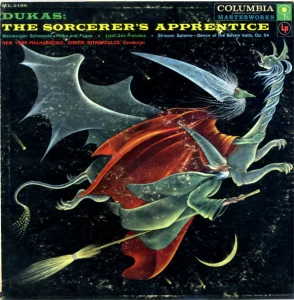Ask someone who’s seen the 1940 animated film, Fantasia, which piece they best remember, and the majority will respond with, “The Sorcerer’s Apprentice” or “the one with Mickey Mouse.” (Runners up might include Bach’s “Toccata and Fugue,” Tchaikovsky’s “Waltz of the Flowers,” or Mussorgsky’s “Night on Bald Mountain,” but that’s a blog for another time.)
Now ask those who chose “The Sorcerer’s Apprentice,” first, if they know who the composer was, and second, what else he composed.
Yeah. Trickier.
Since childhood, I’ve always loved Fantasia and its treatment of Dukas’ 1897 “The Sorcerer’s Apprentice.” It’s mysterious, fun, spooky, shadows and dramatic lighting (the wonderful cinematic touch of the shadow of Mickey’s oversized mouse ears growing ever bigger against the wall are like something out of a Hitchcock film). There’s the cuteness of the magically created servant broom with its jaunty marching steps as it quickly takes to his task of filling and dumping water buckets, that becomes horrifically ominous later on. I love the minute attention given to physical detail, like the aforementioned shadows, the wooden table, the smooth stone steps. These were the days of sublime animation, surely a labor of love as well as a well-honed craft, for the crew at Disney. And the music—oh how perfectly the music matches the story. (And remember, the music came first, by over sixty years.)
Let’s give it a watch.
Sorcerer’s Apprentice – Fantasia
It doesn’t help 19th century French composer Paul Dukas’ case that he was a perfectionist who abandoned or destroyed any composition of his that he felt was below his very high standards. There are a dozen or so compositions of his that remain, but in concert halls they are rarely heard beyond the wildly popular 1897 “Sorcerer’s Apprentice” (or L’Apprenti Sorcier” in his native French).
Born in Paris in 1865 to a mother who was an accomplished pianist (although tragically she died in childbirth when he was five), the young Paul began taking piano lessons. By fourteen he showed a keen interest in composition, and at age seventeen he entered the Paris Conservatoire, to study piano, counterpoint and fugue. Here, he formed a close friendship with fellow student, Claude Debussy, that would last a lifetime. A second-place finish for the esteemed Prix de Rome competition in 1888 frustrated Dukas (remember, he was a relentless perfectionist) and the following year, he didn’t even place in the competition.
Thus humbled (and probably furious with himself), he left the conservatory and, following compulsory military service, set himself up as a composer and freelance music critic. His reviews were well regarded—he was considered one of the most respected critics of his time—and in the 1890’s his compositions found success as well. First was his “Polyeucte Overture” (1891), then his stunning Symphony in C Major (1896) which received a mixed reception at its premiere, followed by the blockbuster “L’Apprenti Sorcier” when he was thirty-two. Dukas based his symphonic poem (sometimes referred to as a scherzo for Orchestra) on a 1767 poem by Johann Wolfgang von Goethe, titled Der Zauberlehrling, that is so close to the Disney Fantasia version, I won’t even bother to summarize it but you can read it HERE.
Audiences went crazy over it. It was an overnight success, and its success grew and grew.
Dukas kept working, of course (and destroying any composition he found faulty). Following other major works like his opera, Ariane et Barbe-Bleue and the ballet, La Péri, he became a professor at the Paris Conservatoire in 1910, where he taught orchestration and, eighteen years later, adding composition. By all accounts, he was an excellent teacher who genuinely cared about imparting his considerable knowledge onto his students. He remained a powerful figure in France’s classical music world, one of the best known of his generation. (There continued to be the amazing Debussy, sure, but the two always maintained their friendship, which says something about Dukas. Not everyone wants to be a one-hit-wonder as their friend really crushes it in the concert halls.)
Give a listen to some of his gems that, regrettably, one never hears in today’s concert halls (Why???) Here is his Symphony in C. It’s a delight. I’m shaking my head in wonder that I’ve never heard it before. It’s lively and cinematic and reminds me a bit of Saint-Saëns’ Symphony No. 3 (the Organ Symphony) and a little of Schumann’s “Rhenish” symphony.
And check out, as well, Dukas’ Piano Sonata in E-flat minor HERE. Again, my thought upon hearing it for the first time, this past week, was, where has this been all my life? Listening to it, I hear Chopin, Fauré, even Grieg. Dazzling. Stunning.
October is still a ways off, but in the subtly shortening days, there’s a feeling of harvest, of Halloween in the air. Or maybe it’s simply that I’ve binge-listened to “The Sorcerer’s Apprentice” while working on this blog and coincidentally—or not—it’s on my “10 Spooky Classical Faves for Halloween” blog from years back that you can find HERE. Saint-Saëns’ Organ Symphony is there as well. I will argue that you should listen to it and Dukas’ Symphony in C back-to-back. Let me know if you, too, think they’re a great match-up.


